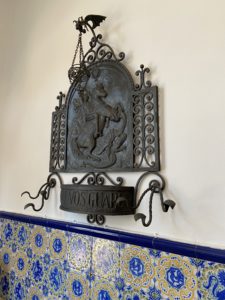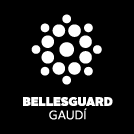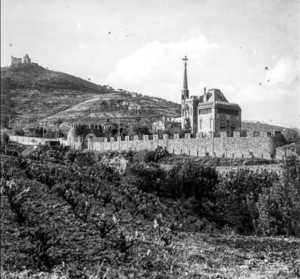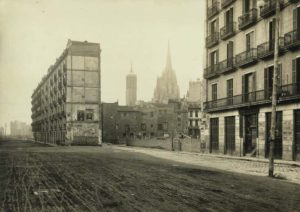January 26, 2024
By: Ferran Garcés

Taking advantage of the feast of Saint Anthony Abbot, the patron saint of animals, last Friday, we began a series of articles about Bellesguard’s peculiar bestiary. The first installment took us to the fish in the exterior mosaics of the main façade (link to the article). Today, we’ll continue with the fauna waiting for us inside the house, in the vestibule. First, we’ll talk about the roosters and lions that decorate the tiles on the walls of the vestibule, and then about the horse that beautifies the iron hanger located at one end of the same room. Like the fish on the façade, the animals in the vestibule were added in 1916, during the time of Domènech Sugrañes, a collaborator of Gaudí who completed Bellesguard a few years after the master left the project in 1909. It’s not clear which of the two decided on the decorative motifs with an animal theme. In any case, they have been part of the tower since the Figueras family, the first owners, settled in it at the beginning of the 20th century.
Historical references?
The combination is quite curious: roosters and lions. What do these animals from such different natural environments have to do with each other? The presence of the king of the jungle can be easily explained. As a symbol of royalty (1), lions could refer to Martí I the Human, the monarch who resided in the Bellesguard castle that inspired Gaudí to design the current building. But what about the rooster? What or whom could it represent?…
According to the archaeologist Manuel Medarde, the first director of the Bellesguard Research Team, the rooster and lion would be an allusion to the heraldic animals on the coat of arms of Margarida de Prades, Martí I’s second wife (2). However, Josep Maria Figueras i Bas, a descendant of the first residents of Torre Bellesguard, proposed a different explanation (3). In his opinion, the rooster would represent a French queen due to the association of roosters with France. Specifically, Violant de Bar, a member of the lineage of the Dukes of Bar, related to the Valois dynasty, the royal house of France at the time. Through her marriage to John I The Hunter, Martí I’s brother, this French monarch also became a member of the Casal de Barcelona. Interestingly, she would be the last representative of the lineage to reside in the old Bellesguard castle, after Queen Margarita de Prades abandoned it. No other member of royalty slept within its walls again. The subsequent owners would be nobles, like Cecilia de Urgell, or wealthy men, like Joan Gualbes, but never again a king or queen.
Religious references?
Another possibility is that these animals have a spiritual meaning. For Christianity, the lion embodies the so-called “Lion of Judah,” the personification of Christ as the king of kings. The rooster, the animal that announces the arrival of the day, also evokes Christ as the conqueror of darkness and the promise of life after death (4). However, no document has been preserved that clearly specifies why Gaudí or Domènech Sugrañes chose these allegorical motifs to decorate Bellesguard’s vestibule. Consequently, any interpretation, whether historical or religious, remains a conjecture. At least, regarding the roosters and lions. On the other hand, the explanation for the presence of horses seems less ambiguous… The horses… We see the horse in the only piece of furniture that has been preserved from the time of the Figueras family. It is an iron hanger with an engraving depicting the legend of Saint George and the dragon. As expected, the horse we refer to is the one ridden by the knight in his battle with the dragon. This year, there is no other horse. However, in Gaudí’s time, horses were not limited to just decorating houses. The evidence is in the stable trough that still exists at Torre Bellesguard, a reminder of a not-so-distant time when not only knights rode horses…


Well, so far we have seen the “real” animals of Bellesguard: fish in the previous article, and today, roosters, lions, and horses. Next Friday, paraphrasing the title of a novel by the well-known writer J.K. Rowling, we will delve into Bellesguard’s world of fantastic beasts and where to find them…
Notes
(1) For more information: Bernabé y Martín de Eugenio, Luis Valero de: “El León y su diseño heráldico,” Link
(2) Vall i Comaposada, Josep M.: Bellesguard. De la residencia del rey Martín a la torre de Gaudí, Barcelona, City Council of Barcelona, 2014, p. 119
(3) Figueras i Bas, Josep Maria: La familia Figueras. Los señores de Bellesguard, Self-published book, 2016, p. 91-92
(4) Gónzález, Teresa, and Alert, Fina (2011), The hidden bestiary of MNAC, “Gall,” MNAC Education Department, Barcelona p. 41-42. Link




